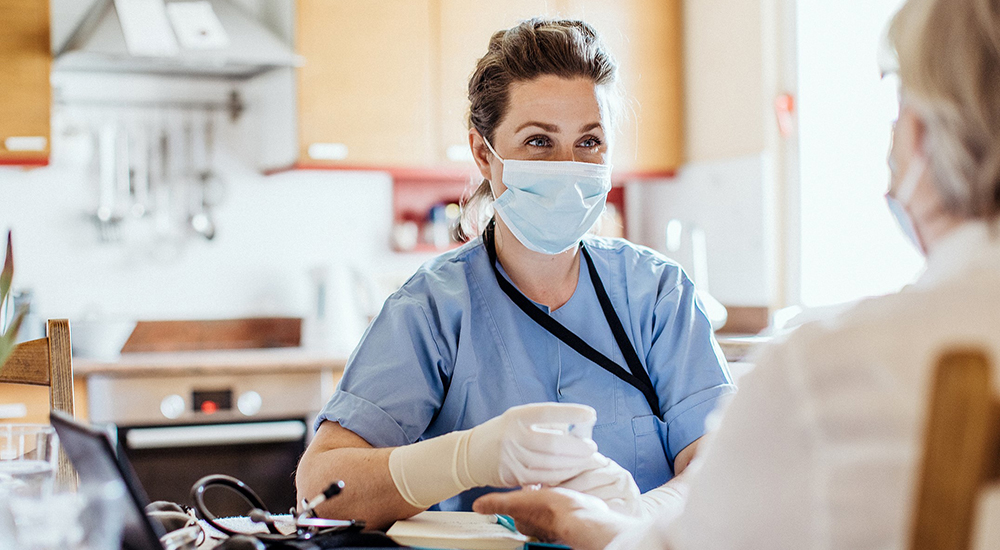Face Coverings and Eye Protection: What kind of protection or source control do they provide? How can they work together to keep you safe?
Face coverings, with their variety of forms and colors, are more than this summer’s newest fashion statement. COVID-19 cases have exploded in the U.S., with no end in sight. Face coverings are one of our best protections against infection in the absence of a vaccine. Also necessary are physical distancing and hand hygiene.
The Centers for Disease Control and Prevention (CDC) has recommended people wear cloth face coverings in public for months. Face coverings that cover the face and nose are effective barriers. They help prevent respiratory droplets from traveling into the air and onto other people. They also trap germs/viruses when the person wearing one coughs, sneezes or talks. Eye protection such as goggles or face shields are not universally recommended by the CDC for the public at this time, but they can provide protection from respiratory droplets to the eyes of the person wearing it. This is especially important when it is difficult to maintain 6 feet of physical distance from others.
Wearing cloth face coverings can help reduce the spread of the virus that causes COVID-19 by people who have the virus but do not have any symptoms. This is called “source control.” Universal source control occurs when everyone wears such coverings. Then, we are all protecting each other, in case we have the virus but not the symptoms. Source control is needed in situations where physical distancing cannot be maintained.
Face shields versus face coverings
The rise of summer temperatures increases the potential for mild discomfort and even irritation when wearing a face covering. As a result, many have begun to wonder if alternatives exist. Questions about the use of face shields without masks as the only source control measure are raised especially when individuals are unable to wear face coverings or face masks for source control.
Face shields are devices that have a transparent window or visor supported in front of the face and provide a barrier of protection to the facial area and related mucous membranes (for example, eyes, nose, lips and mouth). There is little research on the effectiveness of face shields alone for prevention (source control). Face shields may provide some level of source control (to prevent a person from spreading respiratory droplets to another person), but not recommended as the only means for source control, unless a person is medically unable to wear a face covering or mask.
Wearing a face shield, in addition to a face covering or face mask, can provide protection of the eyes of the person wearing it. A face shield alone may feel more comfortable in the heat, but it is not a replacement for a face covering or mask at this time. You may choose to wear one to protect your eyes, in addition to a face covering or mask.
Preventing respiratory droplets
While face masks or face coverings may feel hot and mildly uncomfortable for a few users, they form a tight fit that prevents the wearer’s respiratory droplets from spreading to others. That’s something a face shield does not do.
Currently, the CDC recommends the use of face coverings as source control for everyday activities for the public. However, there is not enough data to support the use of face shields for source control.
Health care workers, in the health care setting, who care for patients known or suspected to have COVID, wear eye protection (e.g. a face shield or goggles, etc.) in addition to a face mask. This is because COVID may be spread by respiratory droplets into the mucous membranes of your eyes.
For now, VA health care personnel will continue to follow CDC recommendations and wear face masks and eye protection such as goggles or face shields due to the increased risk associated with daily exposure to patients who be COVID-19 positive. Veterans and visitors are required to wear a face covering when entering any VA facility, and that face covering should be worn whenever in public. Stay well!
Marla Clifton is the clinical programs coordinator and Kathleen DeRoos is the healthcare-associated infections clinical program coordinator for the VA National Infectious Diseases Service.
Topics in this story
More Stories
VA’s latest data shows a decrease in the suicide rate among women Veterans, but more effective interventions and support systems are needed.
Making healthy choices about what you eat and drink is a powerful way to care for yourself. You need the right fuel to feel well and have the energy to do what matters most to you.
Blind TeleRehabilitation offers blind and visual impairment rehabilitation assessment, training, specialized technology and support groups.







SW, you should be sequestered in home for several months with one, disabled keyboard.
Lets ask the audience, shall we?
Masks don’t interfere with breathing, that’s a lot bull put out by ppl who don’t want to wear a mask. Dr from UK ran 22 miles and tested air quality behind mask for entire run and very little drop in the oxygen level than without a mask. You may not like wearing a mask but it’s not gonna hinder your breathing. Do some research.
So, how does all this apply to people who have breathing issues and a lot of difficulty breathing with a face mask on/ Guess they are supposed to sequester at home until whenever if their doctor refuses to write an exemption or allow them to use a face shield instead.
If You are like Me and have problems with Breathing, then You Can Insist on a Bullsht Face Shield or Lose Your VA HEALTHCARE ( COMMUNIST GOVERNMENT BLACK MAIL ) !!!! And let’s Hope it Ends on NOVEMBER 3rd. 2020 !!! Good Luck !!!